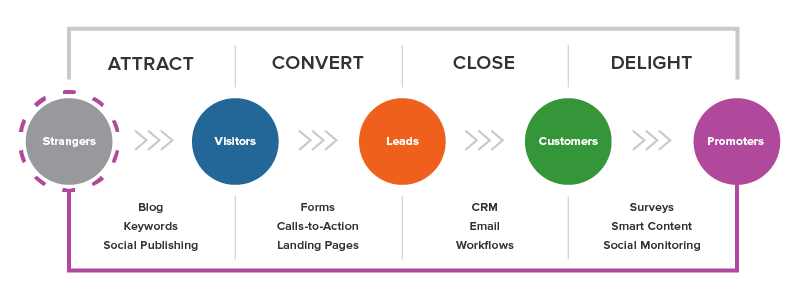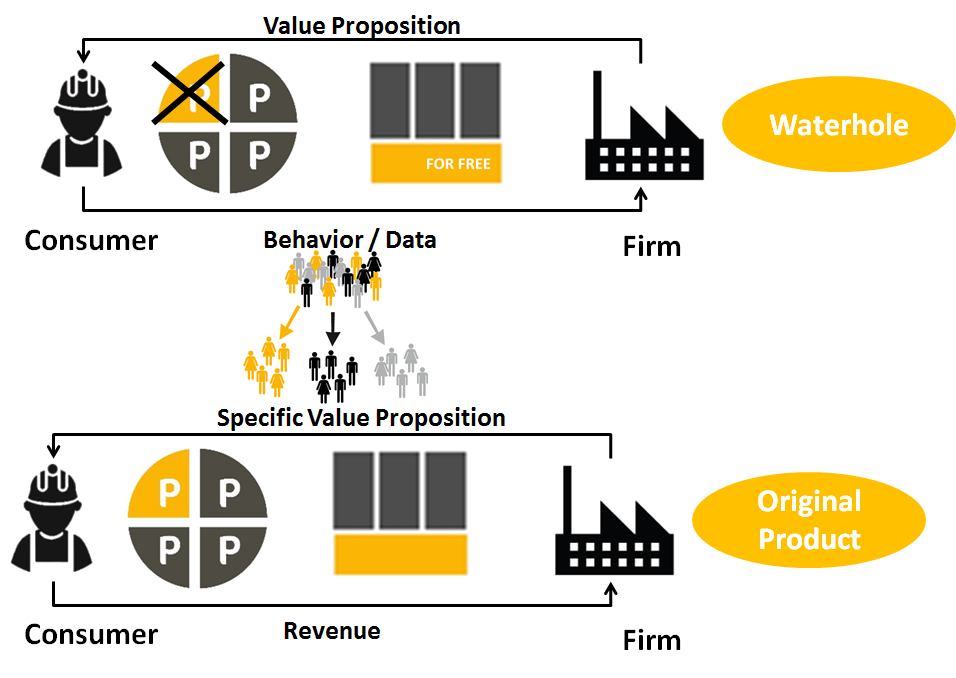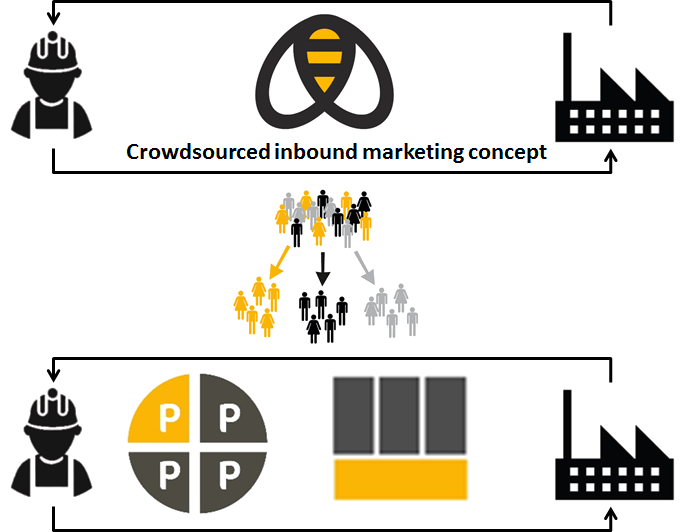Author: Michael Czarniecki January 3rd 2017
The content of this article is:
• What is inbound marketing?
• Critique on the current inbound marketing literature.
• How inbound marketing is combined with the "Internet of Things" trend.
• Recommendations for your business.
What is inbound marketing?
In this article I would like to present a helpful model for inbound marketing. It’s been developed by the BEEUP-Team “FIPRO” while solving the following case study.
It’s a great joy to see eager and problem-oriented users take part in our crowd. The usefulness of their model is its generic design. It allows marketers to link inbound marketing into their existing marketing strategy and to find more diverse and more creative solutions than with existing inbound marketing models.
Inbound marketing has been widely cited as a marketing method that makes sure that a marketer “gets found by people” and does not need to “find people” (Halligan, 2010). There is a nice analogy from the animal kingdom for inbound marketing when compared to more traditional outbound marketing methods.
Let us consider a lion who likes to render a service to the buffalo, namely that he would like to eat it. In the outbound marketing context, the lion goes hunting, he roams the savannah and whenever he sees his prey, he tries to catch it, investing a lot of energy in the process. An alternative for the lion – inbound marketing - is to lay a trap at a waterhole. The lion waits with minimal energy investment. A thirsty buffalo shows up, unaware of its benefactor waiting in the rear. The two conclude a deal (e.g. the lion eats the buffalo) with minimal energy investment for the lion. The return on investment seems to be far higher at the waterhole.

Fig. 1: You can run, but you do not need to. Or so they say.
Stories like this are useful when illustrating the idea, but they do not reveal how a company should use inbound marketing in practice. Recommendations often conclude with catchwords like “search engine optimisation” (SEO), “social media” (SM) and “blogs”. These might be good recommendations and worth acting on. But in my own consulting experience, the recommendations do not go deep enough because they do not provide the necessary framework to answer:
a) How to link the inbound marketing strategy to the existing strategy, structure and culture of an organisation. Implementation is far easier when new measures are linked to an existing strategy.
b) How to act strategically in the face of competition. After all, the lion is not the only predator waiting at the waterhole. It’s often the case that another-industry-blog is the wrong answer.
c) How to analyse the problem properly without referring immediately to SEO and SM. Other highly effective solutions might get lost in an immediate problem-solution frenzy.
In our opinion, today’s models don’t sufficiently address these problems because they are aimed at the process level, and not at the strategic level.
Today’s situation: Process Model
The usual model that inbound marketers provide looks more or less like this:

Fig. 2:The inbound marketing funnel, as often proposed by inbound marketers (source http://www.hubspot.com/inbound-marketing). It is a very helpful process, but it has problems at the strategic level.
As you can see, today’s inbound marketing model is represented as a process. At first, your customers are strangers. They notice you via Google, because you have targeted the correct keywords. If your landing page serves their needs and if your CRM operates properly, they will become your customers and your fans after a length time.
But processes are usually defined after the company has decided on a strategy, because a process is a building block of a structure of an organisation (“culture follows structure follows strategy”). Accordingly, if you want to help to implement inbound marketing tools at the strategic level, you will run into troubles with a process model such as in Fig 2. It is offered too early! It is as if you got the meal before the menu in a restaurant. Furthermore, if you have keywords which are heavily contested among other companies, this model will not tell you how to differentiate from your competitors. It is not generic enough for strategists, because it already provides the answers to your problem (“write blogs”), whether or not this answer fits your organisation from a strategic, structural and cultural perspective.

Fig. 3: The core of the 3rd gen St.Gall Management Model according to (Rüegg-Stürm, 2010). The structure of an organisation, of which the processes are a part of, is highlighted. As you see, organisational development follows the path from strategy to structure to culture.
The bottom line is that models of this kind are appropriate for companies that have already decided to apply inbound marketing at a strategic level. But these models do not serve the purpose to evaluate inbound marketing at the strategic level.
A model that has been proposed by a BEEUP-Team addresses these problems.
A New Model: A Strategic Model
The model starts by making a distinction between a “waterhole product” and an “original product”. As the labels suggest, the former refers to a product which is very much sought after by the consumer (what are they thirsty for?). The latter is actually your “original product” which you hoped to sell in the first place. The recipe is: Give the waterhole product away for free (if necessary, dig the waterhole), and build a relationship to your prospective consumer. Once you understand the behaviour of the users of the waterhole product, you can segment them according to their behaviour, which is a much more precise way than the traditional social-demographic segmentation criteria.
In order to build a marketing strategy in the inbound marketing context you need to define each point in the marketing concept twice. Once for the waterhole product, another time for your original product (except maybe only for pricing, because it is for free in the waterhole product – but you could question this one as well). In the model, these extra efforts are represented by the icons for the Business Model Canvas and the four P’s of the Marketing Mix in the relationships between the consumer and the firm.

Fig. 4: Model for inbound marketing. Our “waterhole model”
The ‘Waterhole Model’ requires that you make an extra effort for your firm and work through all of these concepts. This might deter you from applying the model because defining the business model canvas for your current business is hard enough. If you think this additional effort is hard to justify, keep on reading and perhaps you will be convinced.
Example
Let us go back and make the case for what is usually proposed as an inbound marketing strategy: Search Engine Optimisation. The waterhole product in this case is the information brought to you by Google. Your prospective consumers are thirstily searching for a piece of information – let’s say baby shoes. They rush to Google because it’s the waterhole for information. In the next step, they use the waterhole product (e.g. they enter “Baby shoes for my lovely child”). If you are selling baby shoes and you’ve managed to get a high Google ranking not only on shoes but also on love and babies, your consumer will turn to you and will increase your revenue. In this case, the baby shoe is the original product in the model, as you have recognised.

Fig. 5: Google Search results for “Baby shoes for my lovely child” (left) as opposed to merely “Baby shoes”. Source: Google.
The example with the baby shoes has shown that it does not need to be the lion digging the waterhole at all. Google has done this work for you. In recognition of this, you might now try to outsource those activities and not bother yourself any longer. And you would be absolutely right in doing so. You did not plan these activities on the strategic level, after all. But isn’t this a me-too strategy?
Outsource?
As we have seen, the business offering the waterhole product and the business offering the original product were not the same. There are companies that excel in delivering the waterhole product: Google, Facebook and LinkedIn just to mention the obvious. What is more, it is very straightforward to use those services. They are well-known. They are experienced. They have lots of data. And they operate a very different business model then yours. As a business, you might use these services, label them as “social media marketing”, and outsource it to a marketing agency that will use the existing waterholes for our marketing. In most cases this is not only a good decision but also a necessary one. You will get found by users who actually want your baby shoes. This is the best match, because you sell your products, Google earns money and your consumers are satisfied (“Win-win-win”). This is the reason why Google, Facebook and the like are valued so highly by financial markets. They fulfil one of the most important tasks in an economy; they match supply with demand. As such, it is a quick and easy decision to outsource the service and stop bothering yourself with it.
After recognising the benefits of these ‘waterhole’ services, let us take a step back and make a thought experiment. What if there was no Google? No Facebook? No waterhole. What would you do? Would you roam the savannah again?
What kind of waterhole would you use if you could not outsource?
Beyond Google and Facebook

Fig. 6: No waterhole: The internet without Google?
One answer to what would you do without Google might be to do nothing, because your competitors are unable to do anything either. Alternatively, you could start providing your prospective clients with other give-aways that create a relationship with you and signal their behaviour. But what would you do in this case? Start building Google? Maybe, but much more likely choice would be to engage in activities that are close to your core competency. In this case, the waterhole product doesn’t have to be an internet service. It certainly can involve the internet. But if you’re an engineering company, for example, the odds are high that this would involve the internet of things rather than the internet alone. This gives you an opportunity to create your own waterhole, your own Google so to speak. But if you want to create your own waterhole product, what kind of properties does it need to have? I listed a few which might help:
1. Your target consumers are thirstily looking for the waterhole product. It needs to be in demand. It must fulfil a need.
2. It is possible to create a marketing plan for the waterhole product itself. You need to reach your consumers or your consumers need to reach you.
3. The waterhole product is able to collect data in order to measure the behaviour of your consumers.
4. Your self-made waterhole product needs to be linked to your core competency or to the core competency of your strategic partners (which you can find over at BEEUP, by the way).
Google and Facebook fulfil these criteria for most companies (except for the 4th, and therefore the need to outsource), but with sensor costs going down and diverse internet services increasing in numbers, there are plenty of emerging possibilities that can deliver on these criteria.
Take the case from the BEEUP-Team "FIPRO" as an example. As you see in the case, the client in question has a very specific technology with diverse applications. Its marketing problem is how to find the right engineer at the right moment somewhere in the world in an unknown company. At this very moment, the unknown engineer might make a decision. If he considers our client, our client might earn millions. If not, our client foregoes millions. At one point in the discussion with the BEEUP-team, we discussed the idea of creating a MOOC (massive open online course) for the further education of engineers. You could measure the grades of individual engineers attending the online-course and in particular you could measure their interest on specific technologies. Of course you would need again Google (or more specific Coursera) to market the product, but you would be provided data which is much specific to your marketing problem. In the end, the Team "FIPRO" found a solution that not only involves MOOCs but is also an “internet of things” solution as a waterhole product (the latter, of course, won’t be disclosed here!).

Fig. 7: The new Google for those who are targeting shoe-wearers. Image Source: HKRITA.com
How to create your own inbound marketing strategy?
So what is the model worth? Let us review our discussion from above:
a) How to link the inbound marketing strategy to the existing strategy, structure and culture of an organisation? Implementation is much easier when new measures are linked to an existing strategy.
If you use the ‘waterhole’ model, you can speak to marketers even if they currently use traditional marketing instruments exclusively (e.g. the instruments of the four P’s). You’ll find the four P’s nicely embedded in their marketing strategy and more importantly, in their mindset. Alternatively you can take the business model canvas if you prefer to discuss strategies. Any management tool will do as long as it takes consumer value into account. In fact, you can start defining a whole array of current business tools and embed it in the waterhole model. The marketer that you deal with will understand you and they will recognise the value of inbound marketing. If you can define the variables in the model that they are uncomfortable with, they will then be more inclined to implement it. It will become their “baby” after all and not an off-the-shelf standardised process that’s alien to them.
b) How to act strategically in the face of competition. After all, the lion is not the only predator waiting on the waterhole. It is often the case that another-industry-blog is the wrong answer.
If you apply inbound marketing – for example, Google Ads - then you might realise that the keywords you are targeting are already targeted by your competitors. The same might be true for your blog SEO strategy. There are literally millions of them. I know this from my own experience with BEEUP. When we experimented with Google Ads, we found out that we targeted the same keywords as expensive MBA’s (BEEUP actually delivers the same value to our users, only for free). But our business model does not allow us to pay USD 20 per click. In a situation like this, we would do better starting to dig our own waterhole – by writing articles like this, for example (I hope you were thirsty for this kind of content!). Or maybe we should apply IoT solutions? Who knows what solution fits your core competency best? Perhaps the BEEUP Crowd can show you some possibilities.
c) How to analyse the problem properly without referring immediately to SEO and SM? Other effective solutions might get lost in an immediate problem-solution frenzy.
The digitalisation trend will deliver many more possibilities for inbound marketing than simply over the internet. You might think we are already far advanced with the digital society. After all, almost everybody owns a smart phone. Daimler, the founder of the Daimler car spoke at the height of the car industry of the car industry in the 19th century, that there will never be more than one million cars in the world, due to lack of chauffeurs. We should think of digitalisation in the same context. We are still in the creative phase. One way for your company to recognise the expansion of the digital society is to put a question mark over your waterhole product and let some BEEUP-Teams show you possibilities of reaching your consumers that you would never have envisioned yourself. The result: You will establish a more profound relation with your customers, you will know their needs better. You will be able to deliver on those needs in a more precise way. You will boost your turnover in the end.
Get BEEUP to get more external thinking. Find out more about using the crowd to explore the possibilities of inbound marketing in the digital age.

Fig. 8: You can use BEEUP to get more external thinking how you can develop your marketing, thereby taking account of your core competency and your competitive situation.
References:
Halligan, B. (2010). Inbound Marketing vs. Outbound Marketing. Retrieved from http://blog.hubspot.com/blog/tabid/6307/bid/2989/Inbound-Marketing-vs-Outbound-Marketing.aspx#sm.0000s8av03o78et910jonesiuzw1r
Rüegg-Stürm, J. (2010). Das neue St. Galler Management-Modell. Bern: Haupt.